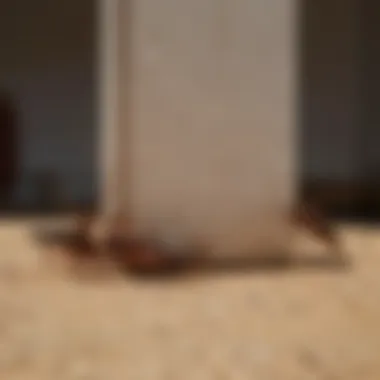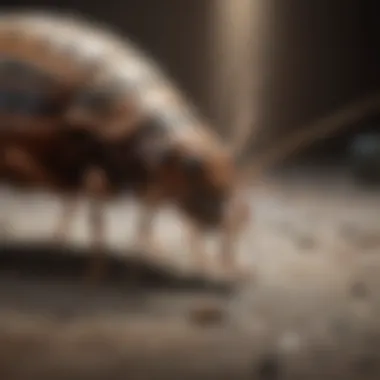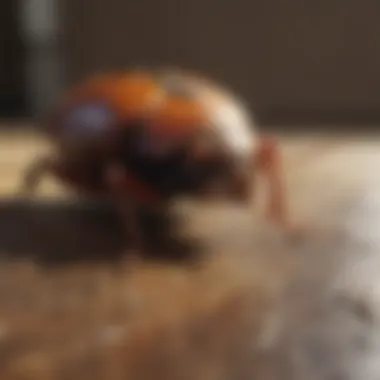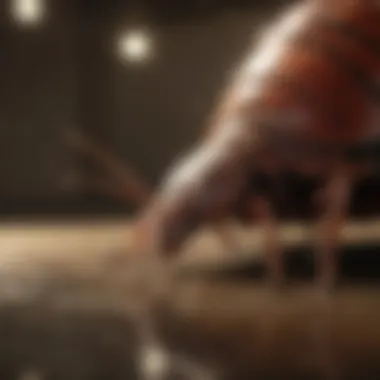Effective House Fumigation for Roach Infestations


Intro
House fumigation is a necessary method for dealing with severe cockroach infestations. It targets the heart of the problem, aiming to eliminate the pests effectively. Understanding the underlying concerns regarding these pests is key. By comprehending the definitions, behaviors, and prevention methods, homeowners can take informed steps toward effective pest management.
Understanding Pests
Definition of Pests
Pests are organisms that negatively affect human activities, particularly in homes. They can be insects, rodents, or other animals. Cockroaches, specifically, belong to the order Blattodea. These insects are resilient and can thrive in various environments, making them a formidable foe for homeowners.
Importance of Pest Identification
Identifying the specific pest is crucial for effective eradication. Not all pests respond to the same treatment methods. For cockroaches, recognizing the species can assist in selecting appropriate fumigation techniques. Knowing their habits and habitats enhance the strategy for tackling an infestation.
Prevention Techniques
Home and Garden Preventative Measures
Preventive measures are essential in keeping roaches at bay. Simple changes can make a significant difference.
- Seal cracks and crevices in walls and foundations.
- Keep food stored in airtight containers.
- Maintain a clean environment by regularly cleaning crumbs and spills.
- Check for damp areas, as cockroaches are attracted to moisture.
Seasonal Prevention Tips
Cockroaches can be more active in certain seasons. Awareness of their seasonal behavior can guide homeowners. During warmer months, they tend to breed more. Ensuring thorough inspection and control measures can prevent rapid population growth.
Eco-Friendly Pest Control Solutions
Overview of Sustainable Practices
Sustainable practices are becoming more popular. Homeowners can utilize strategies that are less harmful to the environment. This includes using traps and organic insecticides that do not introduce chemicals into the home ecosystem.
Natural Remedies and Their Effectiveness
Natural remedies can provide additional support in roach control.
- Diatomaceous earth disrupts the exoskeleton of roaches, leading to dehydration.
- Boric acid is another effective ingredient that can be used carefully to eliminate roaches without a heavily hazardous approach.
Note: Always verify the safety of natural remedies, especially around children and pets.
In summary, knowing how to approach house fumigation for cockroaches requires a well-rounded understanding of pest behavior and prevention. The combination of effective identification, preventative techniques, and eco-friendly practices will empower homeowners to combat infestations more competently.
Understanding House Fumigation
House fumigation is a critical component in combating severe cockroach infestations. Its significance lies not only in its effectiveness but also in the comprehensive approach taken to understand and execute this pest management strategy. By delving into fumigation, individuals can gain insights into its processes, preparation requirements, and necessary precautions. The goal is to equip homeowners and pest control specialists with valuable knowledge that enhances their pest management strategies.
Definition of Fumigation
Fumigation refers to the method of using gaseous chemicals to eliminate pests within an enclosed area. This technique is particularly suitable for cases where infestations are extensive and other methods have failed. Often, professional pest control companies are required to perform fumigation, as it involves specific chemicals that can be hazardous if not handled properly. The process starts by sealing the property, allowing the fumigants to permeate every nook and cranny, effectively reaching roaches that hide in inaccessible areas.


- The primary purpose of fumigation is to eradicate pests, ensuring they cannot survive or reproduce within the infested structure.
- Common fumigants used include sulfuryl fluoride and methyl bromide, both designed to penetrate building materials and eliminate pests thoroughly.
- The duration of a fumigation typically ranges from six hours to several days, depending on the severity of the infestation and the type of gas used.
Fumigation vs Other Pest Control Methods
Fumigation stands apart from traditional pest control methods like traps and sprays for several reasons:
- Effectiveness: Fumigation can eliminate entire populations of cockroaches within a short time frame.
- Reach: Unlike sprays, fumigation ensures that no corner is left untreated. Gases can infiltrate areas that sprays cannot reach.
- Duration: Some pest control methods require multiple treatments and ongoing maintenance, whereas fumigation provides a more instantaneous solution.
However, it is essential to note that fumigation also carries risks and should be considered alongside other methods to determine the best solution for a specific situation. For instance, traditional methods may be less disruptive for minor infestations or in homes where residents include vulnerable individuals, like children or pets. Ultimately, understanding these differences is vital for making informed decisions about pest control strategies in a residence.
The Cockroach Problem
The presence of cockroaches in homes is not merely an inconvenience; it signals a deeper problem that calls for immediate attention. Understanding the issues associated with cockroaches is crucial for effective pest management. These creatures are resilient, adaptable, and often thrive in environments that most people consider clean. By tackling the cockroach problem, homeowners can prevent potential health risks and restore a sense of safety in their living spaces.
Identifying Common Cockroach Species
There are several species of cockroaches that frequently invade homes. The most common ones include the American cockroach, German cockroach, and the Oriental cockroach. Each species has distinct features and behaviors.
- American Cockroach: Characterized by its reddish-brown color and large size, it can fly. Usually found in warm, moist areas.
- German Cockroach: Smaller than the American roach, it has two dark stripes on its back. It prefers kitchens and bathrooms and is known for rapid reproduction.
- Oriental Cockroach: Known for its dark brown to black color, it is not as fast as other species. They prefer cooler, damp locations like basements.
Identifying these species helps in choosing the right extermination method, as each type may respond differently to treatments.
Understanding Cockroach Behavior
Cockroaches are nocturnal creatures, often hiding during the day and emerging at night to search for food and water. They are scavengers and can consume a wide range of organic matter. Their ability to survive in harsh conditions makes them difficult to eliminate. Cockroaches communicate through pheromones, which can lead others to sources of food. Their social behavior can result in rapid population growth, turning a minor issue into a major infestation quickly. Understanding their habits is vital in selecting effective pest control methods.
Health Risks Associated with Cockroaches
Cockroaches are known carriers of various pathogens. They can contaminate food, utensils, and surfaces with bacteria, which may lead to foodborne illnesses. The droppings, saliva, and shed skin of cockroaches also pose significant health risks, particularly to those with allergies or asthma. Some studies suggest that exposure to cockroach allergens can trigger severe asthma attacks in sensitive individuals.
In addition to allergens, cockroaches can transmit diseases such as:
- Salmonella
- E. coli
- Gastroenteritis
It is crucial to address the cockroach problem promptly to safeguard the health of residents, particularly in households with children or elderly individuals.
The cockroach problem in homes should not be underestimated. Ignoring it could lead to severe health implications, making understanding and management essential.
Fumigation Process Explained
Understanding the fumigation process is key to effectively combating severe roach infestations. This section highlights vital steps and considerations that ensure success and safety during the fumigation method. Proper execution minimizes the chances of health risks for residents while maximizing the overall effectiveness in exterminating cockroaches. Each phase serves a distinct purpose, contributing to the final outcome of a pest-free home.
Preparation for Fumigation
Before fumigation can take place, adequate preparation is essential. Preparation involves multiple steps that range across clearing the area, securing food and pets, and assessing the structural integrity of the house. This foundational phase allows for an efficient fumigation process, reducing potential risks while enhancing the effectiveness of treatment.
Clearing the Area
Clearing the area is a crucial step prior to fumigation. In this phase, all unnecessary items are removed from the space being treated. Boxes, furniture, and personal items should not obstruct the fumigation process, as they can hinder chemical penetration. It not only aids in safety but also greatly improves the efficacy of the fumigation treatment itself. Removing all physical barriers allows chemicals to reach every hidden roach.


Securing Food and Pets
Securing food and pets is vital for a safe fumigation process. All food items should be tightly sealed and stored away to avoid contamination. Pets must be relocated to a safe environment, as their health can be severely affected by the fumigation chemicals. This preventive measure is essential for maintaining safety during the treatment, making it a popular choice among households considering fumigation.
Assessing Structural Integrity
Assessing structural integrity involves checking for vulnerabilities in the building that could be exacerbated by the chemicals used in fumigation. Cracks, gaps, or areas where the structure is compromised may allow fumes to escape or not penetrate effectively. Ensuring the house's integrity is fundamental in achieving desired results. This precaution may require repairs, making it beneficial for long-term home maintenance as well.
The Fumigation Execution
The execution of the fumigation follows thorough preparation. This phase involves the actual application of chemical agents designed specifically to target roaches. Understanding elements like treatment duration and the chemicals used is vital for comprehending the fumigation process.
Treatment Duration
Treatment duration is critical as it determines how long the chemicals will remain effective. Generally, a typical fumigation might last anywhere from six to twelve hours, but it may vary depending on the severity of the infestation and specific chemicals used. Proper timing ensures that all stages of the roach lifecycle are targeted, resulting in a more comprehensive extermination.
Chemical Agents Used
Chemical agents used during fumigation are selected based on their efficacy in eliminating cockroaches. Common agents include sulfuryl fluoride and methyl bromide. Each serves a unique function in exterminating pests. In this article, sulphuryl fluoride is frequently noted for its rapid action and minimal residue, making it a preferred option in many scenarios.
Post-Fumigation Steps
After fumigation, it is essential to follow specific post-fumigation steps, ensuring that the area is safe for occupancy. This stage entails re-entry procedures and cleaning, both of which play a role in maintaining a healthy living environment while also eliminating possible traces of chemicals.
Re-entry Procedures
Re-entry procedures are protocols that define when and how residents can safely return to their homes after fumigation. Strict adherence to these guidelines ensures safety, as it minimizes health risks associated with lingering chemicals. Typically, it is advised to wait at least 24 hours before re-entering, but this may vary based on the chemical recommendations provided by the fumigation service.
Cleaning and Sanitation
Cleaning and sanitation post-fumigation are necessary to ensure no chemical residues remain that could impact health. All surfaces should be thoroughly cleaned, particularly kitchen areas and spots where food is prepared. This process also prevents reopening pathways for roaches by eliminating potential food sources. Engaging in this effort facilitates a comprehensive pest management strategy, promoting a healthier living space.
Safety Considerations
Health Risks of Fumigation Chemicals
Fumigation uses potent chemicals such as sulfuryl fluoride or methyl bromide to eliminate cockroaches. While effective, these substances can pose serious health risks. Exposure may lead to symptoms like headaches, dizziness, nausea, and respiratory problems. Long-term exposure could have even more severe consequences, including potential neurological damage. According to research published by Britannica, certain chemicals can be harmful even after fumigation is over, making knowledge about these risks essential for residents.
It's crucial to recognize that individuals with respiratory conditions, allergies, or sensitivities may face increased danger. Therefore, understanding these health risks is vital for anyone involved in the fumigation process. Proper planning and precautions can significantly reduce exposure to these harmful substances.
Protective Measures for Residents
To ensure safety during fumigation, several protective measures should be adopted by residents. These steps are meant to minimize risks associated with chemical exposure while keeping inhabitants safe throughout the process. Here are some important considerations:
- Evacuate the Premises: All residents, including pets, must leave the property before the fumigation begins. Staying away from the treated area reduces risk exposure.
- Inform Neighbors: It is advisable to notify neighbors about the fumigation schedule. This communication helps prevent any unexpected exposure from nearby properties.
- Seal Entry Points: Close all windows and doors tightly to avoid chemicals leaking out or entering other areas not intended for treatment.
- Use Safety Gear: If residents have to re-enter the building for any reason during or shortly after fumigation, wearing safety goggles and facial masks can prevent contact with harmful residues.
- Post-Fumigation Ventilation: After the treatment, allow sufficient time for ventilation to remove lingering chemical odors. Opening windows and doors helps freshen the indoor air.
It is always better to err on the side of caution. Taking safety measures seriously can mitigate health risks substantially during house fumigation.
Failing to address safety considerations can lead to serious aftermaths for residents. Hence, understanding the risks and implementing protective measures is crucial for safe and successful fumigation, fostering a healthier living environment.


Alternative Pest Control Methods
Understanding the various alternative pest control methods is essential when dealing with a cockroach infestation. While house fumigation can be effective for severe cases, some homeowners may seek different routes for both preventative measures and treatment of existing problems. Each method presents unique benefits and considerations that must be taken into account.
Boric Acid Treatments
Boric acid is a well-known pesticide used in cockroach control. It works by disrupting the digestive system of the cockroach when ingested. This makes boric acid an appealing choice for homeowners looking for a less intrusive method. However, using boric acid requires patience. Cockroaches need to come into contact with it to effectively reduce their population. Strategically placing boric acid behind appliances, in cabinets, and along corners can increase its effectiveness.
It is important to remember that boric acid can be toxic to pets and humans when ingested in large amounts. Therefore, it's critical to apply it in areas not frequented by children or animals. Homeowners must be cautious about its use and follow the manufacturers' instructions closely. Regular monitoring of the areas where boric acid is applied will help determine if further treatment is necessary.
Traps and Baits
Traps and baits are another effective alternative for controlling cockroach populations. These devices attract roaches and either capture or poison them. Sticky traps are widely used for monitoring infestations and can provide insight into the severity of the problem. Baits, in contrast, often contain attractive food and a delayed-action insecticide which allows the roaches to carry it back to their colonies, offering the potential for a wider reach of control.
There are various types of baits available, including gel baits and bait stations. Homeowners should select a product that fits their specific situation. A combination of traps and baits can yield better results than using only one method. Regularly checking traps also helps in maintaining control and ensuring that the infestation does not escalate.
Natural Remedies
In the search for eco-friendly pest control methods, many homeowners turn to natural remedies. Some popular natural options include the use of diatomaceous earth, essential oils, and soap solutions. Diatomaceous earth is a fine powder that damages the exoskeleton of cockroaches upon contact, leading to dehydration and death. It is non-toxic to humans and pets when used correctly.
Essential oils, such as peppermint and tea tree oil, have also been touted for their pest-repelling properties. Mixing a few drops with water and spraying around entry points can serve as a natural deterrent. Similarly, soap solutions can disrupt the cockroach’s outer layer and suffocate them when sprayed directly.
While these natural methods may take longer to show results compared to chemical treatments, they provide a safer alternative for households concerned about exposure to toxins. It is important for homeowners to conduct research and consider the efficiency of these remedies before full implementation.
Choosing the right pest control method may greatly affect the long-term success of addressing cockroach infestations.
Each alternative approach to cockroach control has its merits and should be selected based on the specific needs of the household. Whether choosing boric acid, traps, or natural remedies, it is crucial to stay vigilant and adapt the methods as needed.
Long-term Solutions and Prevention
Long-term solutions and prevention strategies are vital in addressing cockroach infestations effectively. While fumigation can provide immediate relief from visible populations, it does not guarantee that future infestations will not occur. A comprehensive understanding of how to maintain an environment that discourages cockroaches is crucial for homeowners. By committing to regular inspections, conducting necessary structural repairs, and utilizing educational resources, homeowners can create a sustainable pest management plan.
Regular Inspections
Regular inspections are one of the most effective tools in preventing cockroach problems. These inspections allow homeowners to detect early signs of an infestation before it escalates. When conducting an inspection, focus on the following areas:
- Kitchens and Pantries: Look for droppings or egg cases, especially in dark corners and behind appliances.
- Bathrooms: Check for leaks and hidden spaces where cockroaches may harbor.
- Basements and Crawl Spaces: These humid areas can attract pests, so monitoring is essential.
Homeowners may consider setting a schedule, inspecting these areas at least every three months. Using a checklist can help ensure nothing is overlooked during inspections, increasing the chances of early detection.
Structural Repairs and Maintenance
Structural repairs and regular maintenance play an indispensable role in preventing cockroach infestations. Small openings and cracks are entry points for these pests. Addressing these vulnerabilities will significantly reduce the likelihood of an infestation. Here are practical considerations to keep in mind:
- Seal Cracks and Crevices: Use caulk to close any gaps in walls, windows, and doors.
- Repair Pipes and Leaks: Cockroaches are attracted to moisture, so fixing leaks in plumbing systems should be a priority.
- Maintain Cleanliness: Regularly cleaning gutters and keeping the home tidy will prevent cockroaches from finding food and shelter.
By prioritizing these structural repairs, homeowners can create a less inviting environment for pests.
Educational Resources for Homeowners
Being informed about pest control methods and the behavior of cockroaches empowers homeowners to act effectively. There are several resources available to educate homeowners:
- Online Articles: Websites like Wikipedia provide thorough insights into pest management practices and benefits.
- Local Extension Services: Many universities offer programs and workshops on pest control, tailored to local conditions.
- Community Forums: Platforms like Reddit have communities dedicated to pest control discussions, where homeowners can share experiences and tips.
Educating oneself can foster a proactive attitude towards home maintenance and pest control. This knowledge can be crucial in implementing effective long-term strategies against cockroaches.

